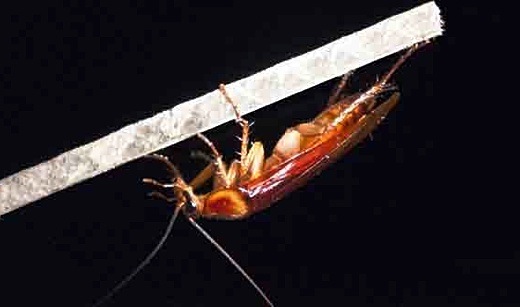 Image above: Roach after making flip over edge of ramp in a fraction of a second. From original article.
Image above: Roach after making flip over edge of ramp in a fraction of a second. From original article.
New cockroach behavior discovered by University of California, Berkeley, biologists secures the insect’s reputation as one of nature’s top escape artists, able to skitter away and disappear from sight before any human can swat it.
In addition to its lightning speed, quick maneuvers and ability to squeeze through the tiniest cracks, the cockroach also can flip under a ledge and disappear in the blink of an eye, the researchers found. It does this by grabbing the edge with grappling hook-like claws on its back legs and swinging like a pendulum 180 degrees to land firmly underneath, upside down.
Always eager to mimic animal behaviors in robots, the researchers teamed up with UC Berkeley robotics experts to recreate the behavior in a six-legged robot by adding Velcro strips.
The UC Berkeley team published the results of the study on Wednesday, June 6, in the online, open-access journal PLoS ONE.
Graduate student Jean-Michel Mongeau of UC Berkeley’s biophysics group said he and his colleagues first noticed the roaches’ newly-identified behavior while studying how they use their antennae to sense and cross gaps.
“As we made the gap wider, they would end up on the underside of the ramp,” Mongeau said. “To the naked eye, it wasn’t clear what was happening, but when we filmed them with a high-speed camera and slowed it down, we were amazed to see that it was the cockroach’s hind legs grabbing the surface that allowed it to swing around under the ledge.”
“Cockroaches continue to surprise us,” said Robert Full, a professor of integrative biology who 15 years ago discovered that when cockroaches run rapidly, they rear up on their two hind legs like bipedal humans. “They have fast relay systems that allow them to dart away quickly in response to light or motion at speeds up to 50 body lengths per second, which is equivalent to a couple hundred miles per hour, if you scale up to the size of humans. This makes them incredibly good at escaping predators.”
Surprisingly, the researchers discovered a similar behavior in lizards, animals that have hook-like toenails, and also documented geckos using this escape technique in the jungle at the Wildlife Reserves near Singapore.
“This behavior is probably pretty widespread, because it is an effective way to quickly move out of sight for small animals,” Full said.
Full’s group then teamed up with the robotics group led by Ron Fearing, UC Berkeley professor of electrical engineering and computer science. In Fearing’ s lab, graduate student researchers Paul Birkmeyer and Aaron Hoover attached Velcro to the rear legs of a small, cockroach-inspired, six-legged robot called DASH (Dynamic Autonomous Sprawled Hexapod). It was able to reproduce the same behavior as seen in roaches and geckos.
“This work is a great example of the amazing maneuverability of animals, and how understanding the physical principles used by nature can inspire design of agile robots,” Fearing said.
Mongeau and Brian McRae, an undergraduate bioengineering major, analyzed the mechanics of the ninja-like maneuver and discovered that the cockroach, an American cockroach (Periplaneta americana), wasn’t merely falling over the ledge. It actually ran at full speed toward the ledge, dove off, then grabbed the edge with its claws – sometimes using only one leg – and swung like a pendulum under the ledge, retaining 75 percent of its running energy.
This pendulum swing subjects the animal to 3-5 times the force of gravity (3-5 gs), similar to what humans feel at the bottom of a bungee jump, Mongeau said.
Full looked at trapeze artists as well as other animals to find a comparable behavior, and found only one well-studied similarity: the tree-swinging behavior of gibbons.
These studies of cockroach and lizard behavior are a hallmark of Full’s biomechanics teaching laboratory, where undergraduate and graduate students put animals through their paces to determine how they walk, run, leap and maneuver. Recently, Full and his students discovered that geckos use their tails to remain upright in midair, stabilize their body during leaping and even steer during gliding. Now, they are focusing on other body parts – abdomens and appendages such as antennae and legs.
“All this must be put together into a complete package to understand what goes into these animals’ extraordinary maneuverability,” Full said.
Aside from helping scientists understand animal locomotion, these findings will go into making better robots.
“Today, some robots are good at running, some at climbing, but very few are good at both or transitioning from one behavior to the other,” he said. “That’s really the challenge now in robotics, to produce robots that can transition on complex surfaces and get into dangerous areas that first responders can’t get into.”
In addition to Full, Mongeau, McRae, Birkmeyer, Hoover and Fearing, the UC Berkeley coauthors include graduate student Ardian Jusufi from the Department of Integrative Biology. Hoover is now a professor at Olin College.
The work was funded by the National Science Foundation, including the NSF’s Integrative Graduate Education and Research Traineeship (IGERT) program, a Swiss NSF Grant for Prospective Researchers, and the Micro Autonomous Systems Technologies (MAST) consortium, a large group of researchers funded in part by the U.S. Army Research Laboratory that is focused on creating autonomous sensing robots.
Video above: Film of roach, gecko and robot stealth maneuver. From Berkeley study. See (http://youtu.be/EP-v1z2prg8). .
No comments :
Post a Comment